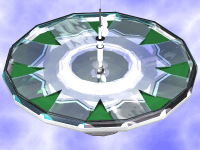MERSEA is a transport vessel for marine aquaculture systems, with the primary goal to re-establish large shoals of marine fish.
The method behind MERSEA is primarily the incremental restoration of depleted marine resource overtime. The vessel includes various hatcheries for marine organisms, including but not limited to fish, crustaceans and molluscs. To restore marine ecosystems MERSEA uses a phased approach, beyond the scope of this article.
MERSEA consists of 7 main parts, together they are assembled to make a massive vessel with an approximate sunlight exposed surface area of 20km2.
A.Central Tower
Accommodates the freshwater storage and processing from condensation acquired from the air. The supermarine section of central tower also accommodates the centralised light distribution collector, where light is focussed onto from mirrors on component B. Additionally the central tower accommodates communication and control facilities, and acts as a lightning conductor to prevent damage to the rest of the vessel.
B.Climate Control Containment
Allows for minor regulation of the ambient temperature, salinity and humidity of sea air, and it is underneath this component that the Greenlayer is tended to provide necessary food provisions for the population of MERSEA.
C.Life Dome
The accommodation area for the majority of the population of MERSEA. The Life Dome is also climate controlled and provides a habitable environment for the onboard animal and bird life on MERSEA.
D.Greenlayer
Consists of many different biomes in order to facilitate the cultivation of coastal food crops and accommodate various species of birds, mammals, insects, reptiles and freshwater fish.
E.Floatation Raft
Provides the necessary buoyancy for MERSEA to float, and in the event of a sinking vessel, consists in part, of a special polymer (in hermetically sealed casings) that reacts with sea water if the seal is broken to form a strong and fibrous foam to provide additional buoyancy. Upon sinking the Hull and Lower Hull are released to sink.
F.Hull
Pressurised typical to submarines, and is attached to the Floatation Raft, but is not part of the Floatation Raft. The Hull contains the majority of the aquaculture facilities and areas in the vessel where certain work takes place. The hull houses amongst other things a super computer and a moulding workshop to replace worn/broken pieces of MERSEA. The hull is made primarily from a polycarbonate composite material that is rigid and completely corrosion resistant. The hull provides the surface on which marine organisms can live and propagate.
G.Lower Hull
Houses the Main Engine Room, Methane Digester, Hydrocarbon Fuel Synthesizer, Submarine Bays, Prisons and Morgue. The lower hull provides essential buoyancy and stability for the massive structure, and houses the structural core upon which the rest of MERSEA is built.
Additionally MERSEA is a survival vessel for a human population of up to 2500 for 500 years. Effectively MERSEA is self governing and would be regarded as a nation in reality. In order to sustain a population of 2500 MERSEA is partially self sufficient. Freshwater, Food and Energy are all provisioned for from on board resources.
Voting
-
ABOUT THE ENTRANT
- Name:Chris Morton
- Type of entry:individual
- Profession:
- Number of times previously entering contest:never
- Chris's favorite design and analysis tools:Autodesk Inventor
- For managing CAD data Chris's company uses:TurboCAD
- Chris's hobbies and activities:Motorcycling, Writing, Arts, Music
- Chris belongs to these online communities:LinkedIn, Yahoo Answers
- Chris is inspired by:Practical Solutions to common problems. Need to find alternatives for energy and water.
- Software used for this entry:TurboCAD, Fireworks
- Patent status:none








